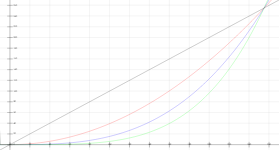-
Notifications
You must be signed in to change notification settings - Fork 38
New issue
Have a question about this project? Sign up for a free GitHub account to open an issue and contact its maintainers and the community.
By clicking “Sign up for GitHub”, you agree to our terms of service and privacy statement. We’ll occasionally send you account related emails.
Already on GitHub? Sign in to your account
Idea: Non-linear dimming #133
Comments
|
This would indeed be nice. |
|
can I assign this one to you @meijer3 ? |
|
Yes for a first setup, but iam not an expert. :) |
|
@meijer3 @MichielVanwelsenaere This python script will generate natural dimmings curves. I'm not the original author so I can't take credit for it. Here's an example where a dimming curve across 256 steps is mapped to 100 increments. The scripts takes arguments which allow you to define the pwm value minimums and maximums between the curve should be calculated in x amount of brightness increase or decrease steps. |
I see the dimmer FB uses

LIN_TRAFO: Util.LIN_TRAFOMost other libraries uses a non-linear like: quadratic cubic or quadruple. I suppose non-linear looks more natural dimming to the human eye.
https://github.com/Breina/ha-artnet-led#output-correction
Extra note:
Personally it is hard to time full brightness with a pushbutton right now.
A small delay at the top of the curve would help. I also know some devides (like my headlight) blinks shortly when it is at max.
The text was updated successfully, but these errors were encountered: